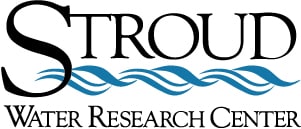Last updated on 2022-09-28
There are two options to Save and Share your Model My Watershed project if you have registered for a free account (i.e., you must have registered for an account). First, make sure you are logged in to your account before you begin a new project.
8.1 Save/Share Using Model My Watershed
Saving your Project. Start a new project by Selecting an Area. Once you have selected and analyzed an Area of Interest AND run either the Site Storm Model or the Watershed Multi-Year Model, your project will automatically be saved to your “Projects”, which can be found by clicking the word “Projects” in the upper right hand corner of the top black bar. Any updates you make to a project, will automatically be saved (thus overwriting your past project with the new edits, no need to click a “save” button). You can Name/Rename or Delete your project in the upper left corner (in the black bar) while viewing your project OR, you can Rename, Delete, Share, and Launch your project from the “projects” page (which lists all of the projects you’ve “saved”).
Sharing your Project. Sharing your project with others from Model My Watershed is simple and can be accessed in two locations. Once you have run either the Site Storm Model or the Watershed Multi-Year Model (and you’re “logged in”), a “Share” button will appear in the upper right hand corner of the black bar. Your click will open a window that contains two options for sharing, “Link Sharing” and “HydroShare Export”. Turn “Link Sharing” on by clicking the “Off” toggle, then copy the URL by clicking “copy”. You can paste this URL into an email or any other document to send to others. The recipient of the URL can click on the link or paste into their web browser to view your project (view only). Projects shared in this way are not editable by the recipient, but remain editable by you (the owner).
8.2 Save/Share Using HydroShare
HydroShare is an online collaboration environment for sharing data, models, and code. When you export to HydroShare, your project will be made public under a Creative Commons 4.0 license.
In order to use this feature, you must:
- Register for a HydroShare account.
- Once you have your HydroShare login credentials, return to Model My Watershed and link your Model My Watershed account with your HydroShare account by clicking on the login text (where your Username is shown in the upper right corner of the black bar) and then click on “Linked Accounts.” You will then be prompted to enter your username and password for your HydroShare account (you should only need to do this once to activate the linking of these two accounts).
- Now that your accounts are linked, you can share projects via Hydroshare with the following steps (you need to do this for each project you wish to share via HydroShare):
- Either (a) click on “Share” within a project you have modeled (upper right corner of the black bar), OR (b) from the “Projects” page you can click on “Share” for any project
- Click on the “Off” toggle button under “HydroShare Export” to turn it “On”
- Enter the “Title” of your project and an “Abstract” (these two fields are required but can be renamed/edited within HydroShare. The Keywords are optional.
- Click “Export” and wait for the project results to be transmitted to your HydroShare account (be patient, this may take 30-60 seconds).
- Once complete, open a new web-browser window and go to the HydroShare website, login, click on “My Resources” and you will see a list of all of the projects you have saved/shared to HydroShare. Click on a project to see the metadata and all other data transmitted to your HydroShare account.
- You can re-open your Model My Watershed project directly from your HydroShare account by clicking on the “Open with…” button towards the upper right corner of your project page and choose to “View” or “Edit” in Model My Watershed. Once clicked, a new tab in your browser will open to your Model My Watershed Project.
Linking and saving your project to HydroShare has several benefits:
- All data files are automatically saved to your HydroShare-My Resources area. That includes all “Analyze” data such as the Land Cover, Soil Types, Animals data and the Model Output files. In addition your “Area of Interest” polygon is exported in multiple GIS formats (.shp, .geojson).
- Your project will now be “discoverable” by anyone within Model My Watershed using the “Monitor” search and should be a resource result under the HydroShare data catalog (see Section 6. to learn how to use).
- You can share your project within HydroShare and transfer “Ownership” of a copy of the project to any other HydroShare member. They can reopen your Model My Watershed project directly from HydroShare using the “Open with” button in the upper right corner of your HydroShare project page. When you share a project in this manner, the new owner can then edit and modify the project that you started. Any changes they make will be saved separately from your original project and saved to the new owners account (either in Model My Watershed or re-shared back to their HydroShare account).
- HydroShare offers features to make your project open to the public (default setting for all Model My Watershed projects – but you can modify to make Private), “Publish” your project to generate a permanent DOI code (Digital Object Identifier) (warning: when you are ready to permanently publish, click the Publish button at the top of the page in HydroShare to request your DOI. Reminder: You may no longer edit your resource, once you have permanently published it.), and you can download all of the files saved to the project.
